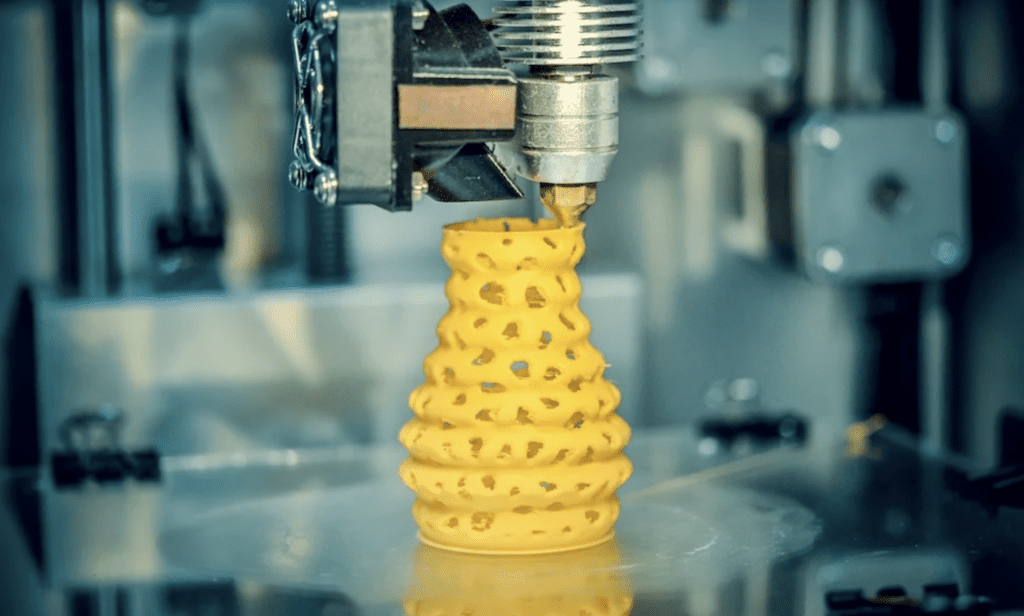In the swiftly evolving tech landscape, Rapid Tooling emerges as a pivotal innovation, transforming prototyping and manufacturing processes. By streamlining the creation of molds and components, this technique significantly shortens development cycles, offering tech industries a competitive edge.
The adoption of Rapid Tooling accelerates product launches, allowing firms to swiftly adapt to market demands and technological advancements. Its capacity to facilitate rapid prototyping and on-demand production underpins the agile methodologies increasingly critical in today’s fast-paced market environment.
Evolution and Impact!

Historical Context
Rapid Tooling (RT) that emerged in the manufacturing industry disrupts the manufacturing process. It is an integral part of additive fabrication and consists of three stages: prototyping, manufacturing, and material development. To start with, recreation of the molds became the easy part of RT. The first systems were SLA, which were the main market players. The factories could reduce tooling from the months to weeks to get it done. RT opened out the horizons in design, allowing ways to iterate on products faster.
Tech Advancement
The breakthroughs and advances of R & R&T are reflected in the evolution of the technology. Laser sintered newer generation has increased the precision and speed yield right from SLA to SLS. In fact, you can find today numerous technical printing solutions like Fused Deposition Modeling (FDM) and Direct Metal Laser Sintering (DMLS) that provide various material options. With the emergence of new technologies, tooling costs reduce, and efficiency increases are observed among industrial sectors.
Manufacturing Shift
RT created a manufacturer model that changed the production paradigm. The hand labor of printing older designs evolved into digital design and automation. Its embrace caused a subsector of custom parts development. Light-weight, multi-purpose or custom made products are produced by industries from aerospace to medical devices within the scope of the rapid prototyping approach. Such talent to fabricate the hugely complicated components in a short time has become a trump card now.
Direct vs. Indirect Rapid Tooling Methods!
Direct Approach
In Direct Rapid Tooling (DRT), manufacturers create tools directly from CAD data, slashing production times. DRT techniques like 3D printing and SLS allow for the making of molds and dies without traditional intermediary steps. This method excels in speed, making it ideal for short-run production and prototypes.
Indirect Method
Indirect Rapid Tooling involves creating a master pattern first, then using it to produce the mold. Techniques like investment casting and silicone injection molding are common. This method is favored for its superior surface finish and material versatility, bridging the gap between prototype and full-scale production.
Core Inserts
Core inserts, integral to RT, allow for complex internal geometries. Manufactured using both direct and indirect methods, these inserts enable the production of parts with intricate features like undercuts and cavities, drastically reducing assembly time and enhancing part functionality.
Master Patterns
Master Patterns serve as the cornerstone in the Indirect Rapid Tooling process. Crafted with precision from composite materials like epoxy and metal, they set the standard for the final tool’s accuracy and detail. Their quality directly influences the mold’s performance and the final product’s fidelity.
| Feature | Direct Approach | Indirect Method |
| Definition | Tooling created directly from CAD | Master pattern used to create mold |
| Technologies | 3D Printing, SLS, DMLS | Silicone molding, investment casting |
| Materials | Metals, polymers, ceramics | Silicones, resins, wax |
| Lead Time | Shorter, days to weeks | Longer, weeks to months |
| Cost | Higher initial, lower per part | Lower initial, higher per part |
| Finish Quality | Variable, tech-dependent | Generally higher, detail retention |
| Complexity Handling | High, suitable for complex geometries | Moderate, depends on master pattern |
| Applications | Prototypes, functional parts | Detailed parts, high-quality finish |
Table on Direct vs. Indirect Rapid Tooling Methods!
Benefits of Rapid Tooling in Tech Industries!
Speed
Rapid Tooling (RT) drastically cuts down development time. By leveraging technologies like 3D printing, companies can go from design to prototype in days, not weeks. This acceleration enables faster iteration, testing, and market entry, crucial in tech industries where innovation cycles are short.
Flexibility
RT offers unparalleled design flexibility. Engineers can easily modify digital models, allowing for real-time adjustments without significant cost implications. This adaptability is essential in tech industries, where product specifications often change during the development phase to incorporate new insights or technologies.
Cost Reduction
By eliminating the need for traditional tooling methods, RT significantly reduces upfront costs. This cost efficiency is particularly beneficial for startups and small tech firms, enabling them to prototype and test ideas without a hefty financial burden, thus democratizing innovation.
Small Batches
RT is ideal for producing small batches, allowing tech companies to launch limited-run editions or conduct market testing without the financial risk of mass production. This capability supports a lean approach to product development, focusing on customer feedback and iterative design enhancements.
Material Selection in Rapid Tooling!

Polymers
In Rapid Tooling, polymers like ABS, Nylon, and Polycarbonate lead due to their versatility. These materials adapt easily to various RT techniques, including FDM and SLS. Ideal for prototypes and functional parts, polymers offer a balance between strength, durability, and ease of processing, catering to diverse industry needs.
Metals
Metals such as Aluminum, Steel, and Titanium are pivotal in RT for high-strength applications. Direct Metal Laser Sintering (DMLS) allows for complex metal parts with excellent mechanical properties. This capability is critical in aerospace, automotive, and medical industries where performance and precision are paramount.
Composites
Composites, blending fibers with polymers, offer enhanced properties like increased strength and reduced weight. In RT, composite materials are tailored for specific applications, making them suitable for sectors demanding high performance, such as automotive and sports equipment, where durability and lightweight are crucial.
Resins
Resins, especially in Stereolithography (SLA) and Digital Light Processing (DLP), provide high-resolution finishes. These materials are chosen for detailed prototypes and end-use parts requiring smooth surfaces finishing and intricate details. Resins are essential in industries like dentistry and jewelry, where precision is key.
Production Efficiency through Rapid Tooling!
Short Lead Times
Rapid Tooling (RT) slashes production lead times. By directly transitioning from CAD models to production-ready tools, companies can cut down development cycles from months to days. This efficiency is vital in fast-paced markets, allowing firms to innovate quickly and stay ahead of the competition.
On-demand Production
RT enables on-demand production, reducing the need for large inventories. Manufacturers can produce parts as needed, minimizing waste and storage costs. This flexibility is crucial for custom orders and limited-run products, allowing companies to respond swiftly to customer demands.
Lean Manufacturing
RT embodies lean manufacturing principles by minimizing waste in the production process of metal casting. By producing precise quantities of components with minimal material waste, companies can optimize resources, enhance quality, and reduce operational costs, leading to more sustainable manufacturing practices.
JIT Inventory
Just-In-Time (JIT) inventory becomes more feasible with RT. By producing parts only when needed, companies can significantly reduce inventory levels, freeing up capital and space. This approach streamlines supply chains and reduces lead times, enabling a more efficient and responsive production model.
| Feature | Short Lead Times | On-Demand Production | Lean Manufacturing | JIT Inventory |
| Definition | Reduction in time from design to production. | Manufacturing parts as needed, no excess inventory. | Minimizing waste, optimizing processes. | Producing goods only as needed to meet demand. |
| Key Benefit | Faster market entry. | Reduces storage and holding costs. | Increases operational efficiency. | Reduces inventory costs, improves cash flow. |
| Technologies | 3D Printing, SLS, DMLS | 3D Printing, CNC Machining | Kaizen, 5S, Six Sigma | ERP Systems, Demand Forecasting |
| Industry Impact | High in fast-paced sectors like tech and automotive. | Ideal for custom orders and prototypes. | Effective in industries aiming for sustainability. | Crucial for industries with fluctuating demand. |
| Cost Implication | Lower upfront costs, higher per-unit cost for low volumes. | Cost-effective for low to medium volumes. | Reduces waste and improves resource utilization. | Minimizes waste, reduces stock obsolescence. |
| Time to Market | Significantly reduced. | Flexible, based on demand. | Optimized production processes lead to faster times. | Depends on supply chain efficiency. |
| Customization Level | High, due to flexible manufacturing processes. | Maximum, produced to meet specific demands. | Adaptable, processes refined over time. | Low to medium, tailored to demand forecasts. |
Table on Production Efficiency through Rapid Tooling!
Cost Implications and Economic Benefits!
ROI
Rapid Tooling (RT) significantly boosts Return on Investment (ROI) by reducing prototype and production costs. With RT, companies can iterate designs faster and at a lower cost, leading to improved product quality and quicker market entry, ultimately enhancing revenue potential and profit margins.
Investment Reduction
RT minimizes initial investment requirements. Traditional tooling methods demand high upfront costs for molds and machinery. RT, leveraging technologies like 3D printing, requires less capital, making product development accessible to startups and small businesses, thus democratizing innovation across industries.
Volume Scalability
RT supports scalable production volumes. Companies can adjust production rates without the need for significant additional investments in tooling, allowing for efficient management of supply based on demand. This scalability aids in optimizing production costs and resource allocation across product life cycles.
Break-even Analysis
RT improves break-even points. By lowering tooling and production costs, companies can achieve profitability at lower sales volumes. This financial flexibility is crucial for new products where market demand is uncertain, enabling firms to take calculated risks with innovative offerings.
Future Directions in Rapid Tooling Technologies!

3D Printing Advancements
Rapid Tooling’s future shines with 3D printing innovations. New printers offer higher precision, faster speeds, and larger build volumes. Upcoming technologies, like multi-material printing, expand possibilities for complex, functional tools in a single print, revolutionizing how industries approach manufacturing and design.
Material Science
Material science propels Rapid Tooling forward. Researchers are developing materials with enhanced properties, like greater durability and temperature resistance. These breakthroughs will enable the production of tools that can withstand harsher manufacturing processes, opening new avenues for RT in sectors like automotive and aerospace.
Digital Manufacturing
The integration of Rapid Tooling with digital manufacturing ecosystems marks a transformative shift. Advanced software for simulation and AI-driven predictive maintenance will streamline the tooling process, reducing errors and downtime. This digital synergy promises a more efficient, flexible, and responsive manufacturing landscape.
Conclusion
Rapid Tooling stands at the forefront of manufacturing evolution, heralding a new era for tech industries. With its unmatched speed, flexibility, and cost efficiency, this method empowers companies to navigate the complexities of modern product development. It paves the way for innovation, enabling swift adaptations and breakthroughs in product design and functionality. Rapid Tooling not only streamlines production processes but also catalyzes the dynamic growth of tech sectors, firmly establishing its role as a game-changer in the industry.




